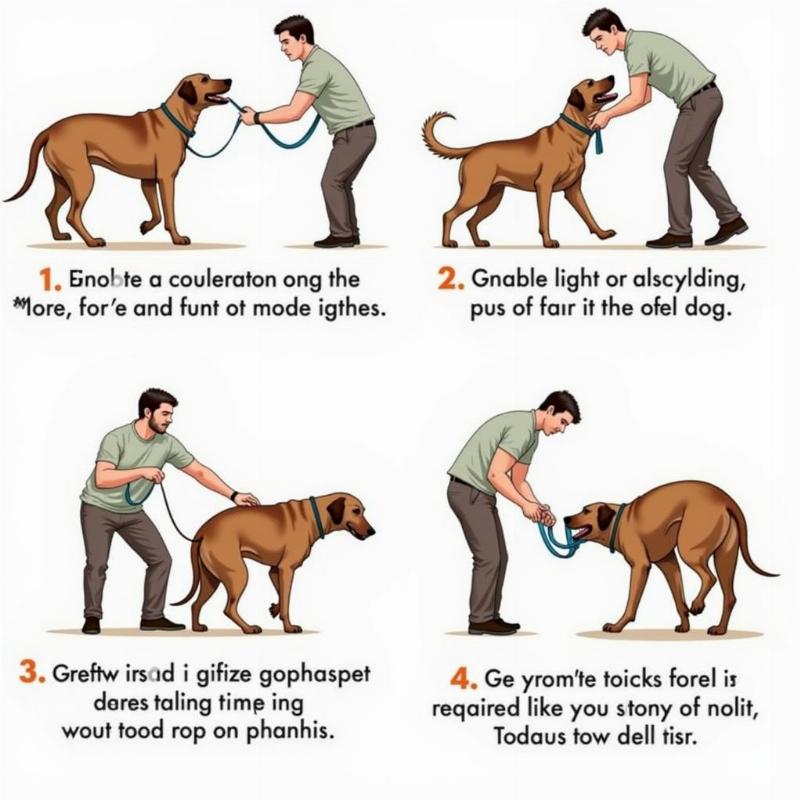Scruffing a dog, the act of grabbing a dog by the loose skin on the back of its neck, is a controversial topic among dog owners and trainers in the US. Is scruffing a dog abuse? The answer isn’t a simple yes or no. While mother dogs use scruffing to control and move their puppies, using this method on adult dogs requires careful consideration and understanding. This article will explore the nuances of scruffing, examining when it might be appropriate and when it crosses the line into abuse.
Understanding Scruffing and its Potential Impact
Scruffing is often seen as a quick way to control a dog’s behavior, particularly in situations where they are being aggressive or disobedient. However, for adult dogs, scruffing can be uncomfortable, painful, and even frightening. Unlike puppies, adult dogs are larger and heavier, making the pressure on their neck during scruffing potentially harmful. It can restrict their breathing and cause unnecessary stress and anxiety. Moreover, scruffing can damage the dog’s trust in their owner and create negative associations.
Scruffing as a disciplinary tool is often debated among trainers. Some argue that it mimics the natural behavior of mother dogs and can be effective in certain situations, while others believe it is outdated and can lead to behavioral problems. The American Kennel Club (AKC) doesn’t specifically endorse or condemn scruffing, but emphasizes the importance of positive reinforcement training methods. Focusing on rewarding desired behaviors rather than punishing unwanted ones generally leads to better long-term results and a stronger bond between dog and owner.
When Scruffing Might Be Appropriate (and How to Do It Safely)
While generally discouraged, there are limited circumstances where scruffing might be necessary, such as during a veterinary emergency or when handling a stray dog for its safety. In these scenarios, scruffing should be done with extreme care to minimize discomfort and potential harm. The grip should be firm but not tight, avoiding any lifting or shaking of the dog. The goal is to briefly restrain the dog, not to inflict pain or punishment.
 Safe Scruffing Techniques for Dogs
Safe Scruffing Techniques for Dogs
It’s important to consult with a veterinarian or a certified professional dog trainer to learn safe and appropriate handling techniques. They can provide guidance on how to manage challenging behaviors without resorting to methods that could potentially harm your dog.
Alternatives to Scruffing: Positive Reinforcement Training
Instead of relying on scruffing, prioritize positive reinforcement training. This involves rewarding desired behaviors with treats, praise, or toys, while ignoring or redirecting unwanted behaviors. This method builds a positive relationship with your dog, strengthens communication, and fosters trust.
Conclusion
Scruffing a dog, especially an adult dog, can be more harmful than helpful. While it might seem like a quick fix for unwanted behaviors, it can lead to fear, anxiety, and even physical harm. Positive reinforcement training methods are far more effective in the long run, fostering a loving and respectful relationship with your canine companion. Remember, a gentle approach combined with consistent training and understanding will always yield better results than relying on outdated and potentially harmful methods like scruffing.
FAQ
- Is it ever okay to scruff a puppy? While mother dogs scruff their puppies, it’s generally best to avoid this with your own puppy to build trust and prevent negative associations.
- My dog bites when I try to scruff him. What should I do? Stop immediately. Consult with a certified dog trainer or behaviorist to address the biting behavior.
- What are some effective alternatives to scruffing for discipline? Positive reinforcement training, redirecting unwanted behaviors, and creating a positive learning environment are all excellent alternatives.
- Can scruffing cause permanent damage to my dog? While unlikely, improper scruffing can cause pain, injury, and behavioral problems.
- How can I learn more about positive reinforcement training? Consult with a certified dog trainer, read books on dog training, or explore online resources dedicated to positive reinforcement methods.
- Are there any breeds that are more sensitive to scruffing? Small breeds and brachycephalic breeds (those with short noses) are particularly vulnerable to breathing difficulties if scruffed improperly.
- What should I do if my dog is exhibiting aggressive behavior? Consult with a certified professional dog trainer or behaviorist immediately to determine the cause of the aggression and develop a safe and effective training plan.
About Beautdogs.us
Beautdogs.us is your premier online resource for all things dog-related in the US. We offer expert advice on dog breeds, care, training, and the latest products and services to enhance your dog’s life. Whether you’re a seasoned dog owner or just starting your journey with a new furry friend, Beautdogs.us is your trusted source for reliable information and expert guidance. Contact us at [email protected] or +1 501-555-7529 for all your dog-related needs!